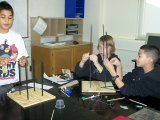-
Category 2
Selected in 2012
-
Grades: 6 - 8
School Setting: rural
Town Population: 8,650
Student Enrollment: 372
Student Demographics:
Black/African American: 3%
Teacher/Student Ratio: 1:18.3
White/Caucasian: 61%
Hispanic: 32%
Hawaiian/Pacific Islander: 0%
Asian: 0%
Native American: 0%
Other: 4%
% Reduced Lunch: 63%
% ELL Learners: 0.5%
Founded: 1957 -
PRINCIPAL:
Brad Anschuetz -
CONTACT:
3498 Treat Highway
Adrian, MI 49221
517.263.0743
banschuetz@madison.k12.mi.us
Madison Middle School
Adrian, MI
Each year our District undergoes a day of strategic planning. This review is lead by a representative from the Michigan Association of School Boards. A concerted effort is made to involve all stakeholders in this process. There are six tables working as a team. Each table, or team, includes a Board member, administrator, two students, one parent, and one community member.
- Describe specific programs in place to ensure that families are involved in the success of your school and students.
-
When completing an internal review of our systems and practices Madison Middle School rated family involvement as an area in need of attention. Currently, we offer a home access center for parents to obtain student performance information on-line. In addition, numerous teachers publish interactive web pages as a means for parents and students to connect with the classroom. A number of parents chaperone events both on and off the campus. Parents, students, and teachers celebrate student success with Honor Roll Breakfasts and an Honors Award Assembly. Finally, a transition night is offered in the spring for incoming sixth grade students.
Parents and studnets are encouraged to be a part of the decision making process as well. Their involvement is facilitated by two methods, surveys and focus groups. As an example, three parents sit on focus group in charge of making decisions regarding the class trip to Boston. Furthermore, a survey is sent out every spring seeking feedback from our stakeholders regarding the handbook. These are examples of our efforts to improve two-way communication. - Describe the most successful activity your school has initiated to strengthen the ties to your community.
-
Each year our District undergoes a day of strategic planning. This review is lead by a representative from the Michigan Association of School Boards. A concerted effort is made to involve all stakeholders in this process. There are six tables working as a team. Each table, or team, includes a Board member, administrator, two students, one parent, and one community member.
The agenda includes a review of the mission and vision statements, review of last year’s goals, review of data centered on last year’s goals, and an outline of targets for the District to meet in years to come. This outline serves to guide members of the District and School Improvement teams. - Describe your philosophy of school change or improvement.
-
The school improvement process drives all change at Madison Middle School. Every initiative introduced since 2005 continues to be implemented. This statement reflects the research undertaken before an initiative is introduced. All such initiates are strategic in nature and reflect best scientifically research based practices.
The School Improvement Team makes 98% of the decisions effecting school processes, curriculum, and instruction. These informed decisions are made after seeking input from all stakeholders, studying data, and reading the research. On rare occasion the building Principal will exercise the right to mandate a position he or she believes is in the best interest of students. - What are your school’s top two goals for the next year?
-
For the upcoming school year our two top goals focus on reading and mathematics. For reading, our goal will be to get 80% of our overall students to read at grade level as measured by the North West Evaluation Assessment. For the purposes of this goal grade level is deemed to be the 40th percentile or higher. Furthermore, in order to close the gap, reading proficiency levels will increase for students with disabilities and Hispanic students a minimum of 5% and 8% respectively.
Our mathematics goal states that the percent of students scoring proficient on the mathematics portion of NWEA will increase by 8% over a period of three years. Furthermore, in order to close the gap, mathematics proficiency levels will increase for students with disabilities and Hispanic students by 12% over a period of three years. - What is the single most important factor in the success of your school that others could replicate?
-
Prior to 2009, Madison Middle School implemented strategies within a small focus area. Beginning with the 2009-10 school year, Madison Middle School made a commitment to employ school wide strategies as a focal point of the annual school improvement process. This commitment included adherence to a yearlong study, as a faculty, of one instructional theme. For the past four years our professional development schedule aligned with a strategic school-wide strategy. In year one, our team concentrated on “reading for comprehension in the content classroom”. In year two, the focus was on “writing to learn”. Student engagement, including Kagan group structures, was year three. Currently, our attention is centered on “academic writing in the Common Core classroom".
By undergoing a yearlong study of an educational strategy our faculty was able to learn and then implement small chunks of professional knowledge into their lesson design. Teachers collected student artifacts as outcomes from their lessons and activities. These artifacts became discussion points at our team meetings. Team members reflected upon quality teaching based on the student artifacts in front of the team. For the first time, colleagues were talking about lesson design and how strategies could be enhanced for future learning. The process of learning, implementing, gathering artifacts, reflection, and tweaking became a continuous cycle of events. This process embedded learning strategies within our educational culture. - Describe the program or initiative that has had the greatest positive effect on student achievement.
-
In 2006 Madison Middle School instituted, at each grade level, a tier 2 reading intervention course titled Reading Workshop. This course continues to be offered to at-risk students in lieu of exploratory rotation classes. The curriculum initially consisted of a program titled Language! by Sopris West. In addition to Language!, we now incorporate Evidenced-Based Literacy Instruction (EBLI) into the lessons as well. Students enrolled in the Reading Workshop course receive an additional 3.5 hours of reading instruction per week beyond their regular Language Arts instruction.
With the increased literacy instruction, utilizing scientifically research-based curriculums, we are able to help a student gain more than one year’s growth in reading. Over the course of three years it is not uncommon for a student to make four to five years of growth in reading. Thus, a student entering the middle school in the sixth grade reading at the fourth grade level can exit to the high school reading at grade level. - Explain how Title I funds have supported your improvement efforts.
- Title I funding at our school provides the personnel to carry out our tier 2 interventions. Such personnel include a Literacy Coach and paraprofessionals in the role of intervention specialists.
- Identify the professional development activities you use to improve the teaching portion of the teaching and learning process.
-
Prior to 2009, Madison Middle School implemented strategies within a small focus area. Beginning with the 2009-10 school year, Madison Middle School made a commitment to employ school wide strategies as a focal point of the annual school improvement process. This commitment included adherence to a yearlong study, as a faculty, of one instructional theme. For the past four years our professional development schedule aligned with a strategic school-wide strategy. In year one, our team concentrated on “reading for comprehension in the content classroom”. In year two, the focus was on “writing to learn”. Student engagement, including Kagan group structures, was year three. Currently, our attention is centered on “academic writing in the Common Core classroom".
By undergoing a yearlong study of an educational strategy our faculty was able to learn and then implement small chunks of professional knowledge into their lesson design. Teachers collected student artifacts as outcomes from their lessons and activities. These artifacts became discussion points at our team meetings. Team members reflected upon quality teaching based on the student artifacts in front of the team. For the first time, colleagues were talking about lesson design and how strategies could be enhanced for future learning. The process of learning, implementing, gathering artifacts, reflection, and tweaking became a continuous cycle of events. This process embedded learning strategies within our educational culture. - Describe how data is used to improve student achievement and inform decision making.
-
A data warehouse, titled Data Director, stores student achievement data, process data, demographic data, and perception data for Madison Middle School. Student achievement data includes North West Evaluation (NWEA) Data, Michigan Educational Assessment Data, ACT Explore Data, local assessment data, and survey data. This data dates back to 2004. Data Director allows our team to create and print five year trend reports. These reports are used mainly to determine school improvement goals.
Year-to-year data is also used to determine student achievement gaps, place students in intervention programs, and determine the success of school wide initiatives. In particular, the NWEA data will outline student skill sets and deficiencies regarding reading for comprehension, language usage, mathematics proficiency, science conceptual understanding, and general science understanding. These assessments are aligned with the Common Core standards.
Once a student’s strengths and deficiencies are understood a prescriptive intervention plan can be put in place to impact student achievement. Supports might include enrollment in a co-taught classroom, tier 2 workshop courses with direct instruction utilizing research-based programs, or tier 2 pullout direct instruction from physical education, music, or exploratory courses. Students in a tier 2 program are progress monitored every two weeks. - Describe your school culture and explain changes you’ve taken to improve it.
-
Since the State of Michigan enacted School-of-Choice legislation the Madison School District, as a whole, has experienced a growth increase of 230%. Madison Schools is touted as a school system that provides a quality education within a family atmosphere. Each of our staff members understands the significance of this perception. Our team members take pride in being a school that takes the time to meet the needs of the individual student. Promotional advertisement slogans read, “Proud to be Part of the Madison Family”.
In order to preserve the family atmosphere perspective Madison Middle School has enacted several initiatives over the years. These initiatives include, but are not limited to, schools-within-a-school, positive behavior intervention systems, and homerooms. Every member of the organization understands he or she is empowered to immediately solve the stakeholders concern. At the very least, he or she can assist the stakeholder with introducing the person to the administrator needed to provide further assistance.
Stats
-
Category 2
Selected in 2012
-
Grades: 6 - 8
School Setting: rural
Town Population: 8,650
Student Enrollment: 372
Student Demographics:
Black/African American: 3%
Teacher/Student Ratio: 1:18.3
White/Caucasian: 61%
Hispanic: 32%
Hawaiian/Pacific Islander: 0%
Asian: 0%
Native American: 0%
Other: 4%
% Reduced Lunch: 63%
% ELL Learners: 0.5%
Founded: 1957 -
PRINCIPAL:
Brad Anschuetz -
CONTACT:
3498 Treat Highway
Adrian, MI 49221
517.263.0743
banschuetz@madison.k12.mi.us










